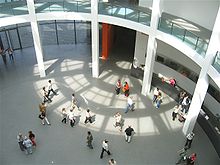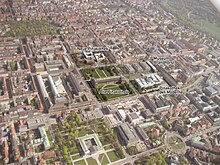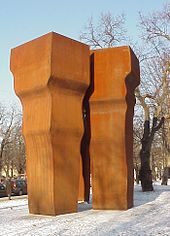Pinakothek der Moderne
The Pinakothek der Moderne on Barer Straße in the Munich art area ( Munich district 3 Maxvorstadt ) is a museum building that opened in 2002 and unites four independent museums under one roof that cover four different disciplines:
- Art : Modern Art Collection (which in turn is part of the Bayerische Staatsgemäldesammlungen ),
- Graphics : State Graphic Collection Munich
- Architecture : Architecture Museum of the Technical University of Munich as well
- Design : New Collection - The Design Museum
The Pinakothek der Moderne ( “ Pinakothek ” , from Greek: pínax (genitive: pinakos) = “painting” and thēkē = “storage”) is part of the Munich art area , in which a large number of cultural institutions are grouped together.
Museum building
Design and construction
The architect Stephan Braunfels designed the modern and open building, which architecture critics unanimously rated as successful, which could only be built because sufficient private donations (start-up financing of ten million euros) had been collected beforehand. Only then did the Free State of Bavaria take over the financing costs and make the property of the former Turkish barracks available, which was already planned for university institutes. The Pinakothek der Moderne was opened on September 16, 2002 and welcomed the two millionth visitor after one and a half years.
Inside the white building made of exposed concrete , two large staircases lead from the double-shell rotunda as the center of the building to the collections. Their total diameter is 30 m. The design collection is located in the basement, while exhibition rooms for the architecture collection, the graphic collection and temporary exhibitions are on the ground floor. The collection of classical modern art is housed in the west wing of the upper floor, the collection for contemporary art in the east wing.
Construction defects
The first construction defects appeared on the building early on. As it became known in July 2012, the deficiencies were so serious that the museum was closed from the end of February 2013 during the planned renovation until September 2013. However, Jürgen Mayer Hermann's unrealized design for the Temporäre Kunsthalle Berlin was set up at the Pinakothek and was used as a temporary exhibition space called Schaustelle from mid-April 2013 .
When the building was handed over in 2002, Braunfels presented the Free State of Bavaria with a list of more than 200 deficiencies ("which have not yet been remedied"). The architect protested against the fact that his name would be associated with the term “botched building”. “The budget was far too low from the start. They assumed 400 euros for the cubic meter of enclosed space, but the average value for 20 large, comparable museums in Germany and Europe was already 700 euros at that time. ”The Brandhorst Museum, for example, cost 1000 euros per cubic meter.
The second construction phase planned by Braunfels, which will enclose the museum building in the south and east and contain additional rooms for the State Graphic Collection, was postponed due to a recent lack of funds, also because the construction of the Brandhorst Museum was brought forward. The Pinakothek der Moderne foundation then bought the rights of use for the second construction phase from the architect in February 2019.
One house, four museums
Art: Collection of Modern Art in the Pinakothek der Moderne
The Modern Art Collection shows works of art, especially paintings and sculptures, from classic modern art to contemporary art. All directions of modern art are represented with their protagonists, such as Expressionism , Futurism , Fauvism , Cubism , New Objectivity , Bauhaus , Surrealism , Abstract Expressionism , Pop Art and Minimal Art . From the now more than 20,000 works, a selection is presented in the 35 halls of the Pinakothek der Moderne.
history
The collection, one of the most important of its kind, was not created until after 1945 through foundations, bequests and acquisitions.
With the reopening of the Neue Pinakothek in 1981 and the separation of the galleries that were once united in the Haus der Kunst, the decisive question for the delimitation was essentially whether a work required the innovations of Henri Matisse and the Expressionists . Logically, a Fauvist picture of Matisse ( Still Life with Geraniums 1910) acquired through the Tschudi donation is already in the Pinakothek der Moderne, as are the works of the Cubists and Expressionists. In contrast to other cities, Munich was almost completely spared from the barbarism of the National Socialists against “ degenerate art ” due to lack of mass. A confiscated self-portrait by Vincent van Gogh would be assigned to the Neue Pinakothek today, and with the aforementioned still life and a sculpture by Matisse, the basis of the State Gallery of Modern Art in 1950 consisted of a total of seven, albeit significant, works of art by Franz Marc ( Red Deer ), Oskar Kokoschka ( Venice ), Lovis Corinth ( delphinium ; landscape with Walchensee ) and Max Beckmann ( self-portrait ).

After the Second World War , the collection of modern painting and sculpture grew rapidly through acquisitions, bequests and foundations. The holdings were expanded in addition to a concentrated collection policy around individual priorities, in particular through the collections “ Theo Wormland ” (surrealism), “ Sofie and Emanuel Fohn ” (confiscated so-called “degenerate art”), “ Woty and Theodor Werner ” (pictures by Paul Klee and the Cubists), "Martha and Markus Kruss" (expressionists, especially the artists of the Brücke ), " Günther Franke " (works by Max Beckmann), " Klaus Gebhard " (North American artists such as Robert Rauschenberg and Jasper Johns ) and the Herzog collection Franz von Bayern with contemporary German painters such as Jörg Immendorff and Sigmar Polke . Another expansion took place in 2006 with the acquisition of the " Eleonore and Michael Stoffel " collection with German and North American art from the 1960s to 1990s.
In 2009 the Pinakothek acquired around 300 works by Joseph Beuys , including 280 multiples and several originals that had previously been on loan at the Pinakothek der Moderne. In 2013, the Theo Wormland Foundation donated its founder's collection of 70 works of surrealism to the collection of classical modernism.
Collection of classical modernism
The artist spectrum ranges from Henri Matisse ( Still Life with Geraniums , 1910), Robert Delaunay ( The Cardiff Team , 1913), Fernand Léger ( Landscape No. 2 , 1913), Juan Gris ( The Bordeaux Bottle , 1913), Umberto Boccioni ( Volumi orizzontali , 1912), Gino Severini ( Synthèse plastique de l'idée: Guerre , 1915) and Georges Braque ( Woman with a mandolin , 1910) on Oskar Kokoschka ( The Emigrants , 1916), Lyonel Feininger ( Troistedt , 1923), Oskar Schlemmer ( Dancer (The Gesture) , 1922–1923), Otto Dix ( Portrait of the photographer Otto Erfurt , 1925), George Grosz ( Woman in a Black Coat , 1927) to Joan Miró ( Composition , 1925), René Magritte ( The Exercises of Acrobat , 1928), Giorgio de Chirico ( The disconcerting Muses , 1917), Salvador Dalí ( The Riddle of Desire or My Mother, My Mother, My Mother , 1929) and Max Ernst ( Hausengel , 1937) and Franz Radziwill ( Grodenstrasse to Varelerhafen , 1938).
Especially Max Beckmann ( Young Argentinian , 1929) ( Triptychon Temptation of St. Antonius , 1936) ( Woman with a mandolin in yellow and red , 1950) and Pablo Picasso ( Madame Soler , 1903) ( Mother with Child , 1921) ( Seated Woman , 1941) are exhibited in two large halls.
All members of the Brücke and the Blauer Reiters are also represented, in particular Ernst Ludwig Kirchner ( Elisabethufer , 1913) ( Circus , 1913) ( dance school , 1914), but also Erich Heckel ( Gläserner Tag . 1913), Emil Nolde ( Tanz um das golden calf . 1910) and Karl Schmidt-Rottluff ( landscape with water carrier , 1919) as well as Paul Klee ( The full moon . 1919), Alexej von Jawlensky ( landscape from Carantec with wife . 1905/1906), Franz Marc ( The Mandrill . 1913) , August Macke ( Girl under Trees , 1914) and Wassily Kandinsky ( Dreamy Improvisation . 1913).
August Macke
Girls under Trees , 1914Wilhelm Lehmbruck
the fallen , 1915/1916Paula Modersohn-Becker
Children's Nude with Goldfish Bowl , 1906/1907Otto Mueller
Two girls in the country , 1920–1925Ernst Ludwig Kirchner
Bohemian Forest Lake , 1911
Art of the second half of the 20th century
Works by Giorgio Morandi ( Still Life with Bottles , 1958), Antonio Saura ( Crucifixión (Triptychon) , 1959), Jasper Johns ( Arrive / Depart , 1963), Robert Rauschenberg ( Composition with football players , 1962), Cy Twombly ( Bolsena , 1969), Willem de Kooning ( Detour , 1958), Robert Motherwell ( Je t'aime , 1955), Franz Kline ( New Year Wall: Night , 1960), Lucio Fontana ( Concetto Spaziale, Attese , 1954 and 1959), Asger Jorn ( Lockung , 1960), Antoni Tàpies ( ocher-colored oval with black incisions , 1965), Francis Bacon ( Crucifixion , 1965), Henry Moore ( Falling Warrior , 1956), Marino Marini ( portrait Igor Stravinsky , 1951), Blinky Palermo ( Straight , 1965), Georg Baselitz ( A new type , 1966), Gerhard Richter ( curtain , 1966), Sigmar Polke ( act with violin , 1968), Anselm Kiefer ( Nero paints , 1974), Joseph Beuys ( The end of the 20th century 1983), Andy Warhol ( Aids / Jeep / Bicycle , 1986), Arnulf Rainer ( cross picture, red, right with H and , 1990) and Neo Rauch ( Wahl , 1998).
A special focus is the holdings of Minimal Art by Donald Judd ( Wallboxes , 1978), Dan Flavin (Monument, 1969) and Fred Sandback (spatial installations for the Pinakothek der Moderne, 2003). There is also an entire monument room by Flavin and 16 wall pieces and three floor pieces by Flavin.
New media, photography and video
The modern art collection has significant individual compositions from this area, for example by John Baldessari ( Man running / Men carrying box , 1988–1990), Tadeusz Kantor ( Die tote Klasse , 1975), Bruce Nauman ( World Peace (projected) , 1996 ), Pipilotti Rist ( Himalaya Goldsteins Stube , 1998/1999), Hiroshi Sugimoto ( World Trade Center, Minoru Yamazaki , 1997), Bill Viola ( Tiny Death , 1993), Sam Taylor-Wood ( Soliloquy III , 1998) and Jeff Wall with its light boxes ( Eviction Struggle , 1988; A villager from Aricaköyu arriving in Mahmutbey, Istanbul September 1997 ).
In 2003 the Pinakothek der Moderne received the Siemens photo collection. This started a cooperation between the Pinakothek and the Siemens Arts Program .
In January 2009, the Pinakothek der Moderne announced that the Ann and Jürgen Wilde Foundation would transfer their extensive photography collection to the museum and incorporate it into the Bavarian State Painting Collections. The Wilde Collection focuses on photography from the early 20th century. The collections include the archives of Karl Blossfeldt and Albert Renger-Patzsch, recognized as nationally worthy of protection, with more than 4,000 original prints, over 10,000 glass plates and extensive archive materials; Groups of works by August Sander , Germaine Krull , Man Ray , Florence Henri , Friedrich Seidenstücker , Bernd and Hilla Becher , Lee Friedlander , David Hockney and others with approx. 1,500 original prints; a photo-historical specialist library with approx. 8,000 volumes on the history of photography in the 20th century, including many first editions and rarities as well as the archives for the Wilde Gallery and Collection
Graphics: State Graphic Collection Munich
The Staatliche Graphische Sammlung München comprises around 400,000 sheets from all epochs of drawing and printmaking from the 15th century to modern times . It goes back to the collections of the Wittelsbach family, in particular the copperplate and drawing cabinet of Elector Karl Theodor . The collection suffered severe losses in the Second World War , but with the collections in Berlin and Dresden it has remained the most important in Germany. The focus is on old German and Dutch drawings and prints (including works by Albrecht Dürer and Rembrandt ), Italian drawings (including by Michelangelo and Leonardo da Vinci ), German drawings of the 19th century and international modern graphics, for example by Paul Cézanne , Henri Matisse , Paul Klee and David Hockney . Due to the sensitivity of the works of art to light, only temporary exhibitions are shown.
Design: The New Collection - The Design Museum

The Neue Sammlung is one of the world's leading design museums and, in its permanent exhibition, shows for the first time the history and development of design and applied art from around 1900 to the present day. It is the largest collection in the world for industrial design . In particular, stocks on the subjects of vehicle design, computer culture, design of jewelry, everyday objects and furniture, including the Thonet collection.
Architecture: TUM Architecture Museum
The collection of the Architecture Museum of the Technical University of Munich is the largest of its kind in Germany and shows temporary exhibitions from its rich holdings, such as drawings, drafts and models by well-known architects from Johann Balthasar Neumann and François de Cuvilliés to Gottfried Semper to Le Corbusier and Günter Behnisch . There are also computer animations and films.
Arts Education / Art Education
The Pinakothek der Moderne offers visitors of all ages numerous guided tours and workshops. In addition to its own team of art educators, various program items are carried out by the Munich Adult Education Center. All events are listed in the house's program. Special opening times and programs are offered for day care centers and school classes.
Discovery tours
The discovery tours for children, a scavenger hunt through the museum, are always available free of charge at the information desk. The tours on various topics are offered in up to six different languages (German, English, Arabic, Spanish, Italian and French).
Children can art ...
Every Sunday children from the age of five can draw, paint and do handicrafts together in small groups.
literature
- Michael Hering (Hrsg.): Pinakothek der Moderne: art, graphics, design, architecture; art, prints & drawings, design, achitecture , German; English. Berlin: Hatje Cantz, 2017. ISBN 978-3-7757-4285-6 .
- Gottfried Knapp : Stephan Braunfels : Pinakothek der Moderne. Munich / Munich. In German and English, architectural photography: Ulrich Schwarz. Prestel, Munich / Berlin / London / New York 2004, ISBN 3-7913-2831-X .
- Andrea v. Martius; Christian Müller-Straten; Adelheid Straten; Bärbel Roth: The Pinakothek der Moderne: A hit with flaws. In: MUSEUM AKTUELL, January 2004.
See also
- State Gallery of Modern Art in the Glaspalast Augsburg
- Turkish Gate
- PIN CODE. Friends of the Pinakothek der Moderne
Web links
- Pinakothek der Moderne
- Modern art collection in the Pinakothek der Moderne
- State Graphic Collection Munich
- TUM Architecture Museum
- The New Collection - The Design Museum
- Pinakothek der Moderne - Interactive 360 ° panorama
- Culture portal bavarikon - works from the Pinakothek der Moderne as high-resolution digital copies
Individual evidence
- ↑ Pinakothek - Wiktionary. Retrieved November 15, 2017 .
- ↑ Renovation requires a six-month break. BR on September 11, 2012.
- ↑ Britta Schultejans: Pinakothek der Moderne: “Schaustelle” of the Pinakothek should inspire young audiences. , Abendzeitung-muenchen.de, April 11, 2013, accessed on May 25, 2013.
- ↑ Franz Kotteder architect Braunfels defends himself - "I am a victim, not a perpetrator". Süddeutsche Zeitung of July 22, 2012.
- ↑ Modern Art Collection. Retrieved November 16, 2019 (German).
- ^ Art : Beuys multiples for Neue Pinakothek. ( Memento of March 19, 2012 in the Internet Archive ) (accessed on August 29, 2009)
- ↑ Theo Wormland Foundation: Wormland donation ( Memento from December 19, 2013 in the Internet Archive )
- ^ Foundation Ann and Jürgen Wilde donates the collection of the Pinakothek der Moderne, Munich. art-in.de
Coordinates: 48 ° 8 ′ 49 ″ N , 11 ° 34 ′ 20 ″ E










